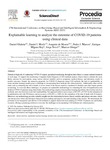Mostrar o rexistro simple do ítem
Explainable learning to analyze the outcome of COVID-19 patients using clinical data
| dc.contributor.author | Olañeta Fariña, Daniel | |
| dc.contributor.author | Iglesias Morís, Daniel | |
| dc.contributor.author | Moura, Joaquim de | |
| dc.contributor.author | Marcos, Pedro J. | |
| dc.contributor.author | Míguez-Rey, Enrique | |
| dc.contributor.author | Novo Buján, Jorge | |
| dc.contributor.author | Ortega Hortas, Marcos | |
| dc.date.accessioned | 2024-05-02T10:20:14Z | |
| dc.date.available | 2024-05-02T10:20:14Z | |
| dc.date.issued | 2023 | |
| dc.identifier.citation | D. Olañeta, D. I. Morís, J. de Moura, P. J. Marcos, E. Míguez Rey, J. Novo, and M. Ortega; "Explainable learning to analyze the outcome of COVID-19 patients using clinical data", Procedia Computer Science, Vol. 225, pp. 238-247, 2023, doi: 10.1016/j.procs.2023.10.008 | es_ES |
| dc.identifier.uri | http://hdl.handle.net/2183/36391 | |
| dc.description.abstract | [Abstract]: Patients at high risk of contracting COVID-19 require specialized monitoring throughout their illness to ensure optimal treatment at each stage. To support this monitoring, Computer-Aided Diagnosis (CAD) methods analyze clinical data to estimate the most likely outcome for each patient, using various clinical variables such as symptoms, medical history, and laboratory results to predict outcomes. Despite the numerous proposals for COVID-19 diagnosis using CAD methods, the lack of explainability in many machine learning models poses a challenge in incorporating these methods into clinical practice. Additionally, other crucial tasks such as estimating the risk of death or severe forms of the disease must be considered to identify cases that require greater monitoring. To overcome these challenges, we propose an explainable methodology for estimating the risk of hospitalization and death in COVID-19 patients using clinical data. Our methodology employs four machine learning algorithms, three feature selection methods, and a decision tree to provide explainability. Our approach achieves an accuracy of 86.16% ± 0.74% for the estimation of hospitalization risk with 29 features, and an accuracy of 86.40% ± 1.80% for the estimation of the risk of death with 26 features. Moreover, our methodology provides valuable insights into the relationship between clinical variables and patient outcomes, which can inform more robust and informed clinical decision-making and improve our understanding of the disease. We demonstrate the potential of our transparent and effective CAD methods to support clinical decision-making in COVID-19 patient care and further research, offering a promising solution to overcome the challenges in incorporating CAD methods into clinical practice. | es_ES |
| dc.description.sponsorship | This work was supported by Ministerio de Ciencia e Innovación, Government of Spain through the research project with [grant numbers RTI2018-095894-B-I00, PID2019-108435RB-I00, TED2021-131201B-I00, and PDC2022-133132-I00]; Consellería de Educación, Universidade, e Formación Profesional, Xunta de Galicia, Grupos de Referencia Competitiva, [grant number ED431C 2020/24], predoctoral grant [grant number ED481A 2021/196]; CITIC, Centro de Investigación de Galicia [grant number ED431G 2019/01], receives financial support from Con-sellería de Educación, Universidade e Formación Profesional, Xunta de Galicia, through the ERDF (80%) and Secre-taría Xeral de Universidades (20%). | es_ES |
| dc.description.sponsorship | Xunta de Galicia; ED431C 2020/24 | es_ES |
| dc.description.sponsorship | Xunta de Galicia; ED481A 2021/196 | es_ES |
| dc.description.sponsorship | Xunta de Galicia; ED431G 2019/01 | es_ES |
| dc.language.iso | eng | es_ES |
| dc.publisher | Elsevier B.V. | es_ES |
| dc.relation | info:eu-repo/grantAgreement/AEI/Plan Estatal de Investigación Científica y Técnica y de Innovación 2017-2020/RTI2018-095894-B-I00/ES/DESARROLLO DE TECNOLOGIAS INTELIGENTES PARA DIAGNOSTICO DE LA DMAE BASADAS EN EL ANALISIS AUTOMATICO DE NUEVAS MODALIDADES HETEROGENEAS DE ADQUISICION DE IMAGEN OFTALMOLOGICA | es_ES |
| dc.relation | info:eu-repo/grantAgreement/AEI/Plan Estatal de Investigación Científica y Técnica y de Innovación 2017-2020/PID2019-108435RB-I00/ES/CUANTIFICACIÓN Y CARACTERIZACIÓN COMPUTACIONAL DE IMAGEN MULTIMODAL OFTALMOLÓGICA: ESTUDIOS EN ESCLEROSIS MÚLTIPLE | es_ES |
| dc.relation | info:eu-repo/grantAgreement/AEI/Plan Estatal de Investigación Científica y Técnica y de Innovación 2021-2024/TED2021-131201B-I00/ES/DIAGNÓSTICO DIGITAL: TRANSFORMACIÓN DE LA DETECCIÓN DE ENFERMEDADES NEUROVASCULARES Y DEL TRATAMIENTO DE LOS PACIENTES | es_ES |
| dc.relation | info:eu-repo/grantAgreement/AEI/Plan Estatal de Investigación Científica y Técnica y de Innovación 2021-2024/PDC2022-133132-I00/ES/MEJORAS EN EL DIAGNÓSTICO E INVESTIGACIÓN CLÍNICO MEDIANTE TECNOLOGÍAS INTELIGENTES APLICADAS LA IMAGEN OFTALMOLÓGICA | es_ES |
| dc.relation.uri | https://doi.org/10.1016/j.procs.2023.10.008 | es_ES |
| dc.rights | Atribución-NoComercial-SinDerivadas 3.0 España | es_ES |
| dc.rights.uri | http://creativecommons.org/licenses/by-nc-nd/3.0/es/ | * |
| dc.subject | feature selection | es_ES |
| dc.subject | explainable machine learning | es_ES |
| dc.subject | decision trees | es_ES |
| dc.subject | outcome estimation | es_ES |
| dc.subject | COVID-19 | es_ES |
| dc.title | Explainable learning to analyze the outcome of COVID-19 patients using clinical data | es_ES |
| dc.type | info:eu-repo/semantics/conferenceObject | es_ES |
| dc.rights.access | info:eu-repo/semantics/openAccess | es_ES |
| UDC.journalTitle | Procedia Computer Science | es_ES |
| UDC.volume | 225 | es_ES |
| UDC.startPage | 238 | es_ES |
| UDC.endPage | 247 | es_ES |
| dc.identifier.doi | 10.1016/j.procs.2023.10.008 | |
| UDC.conferenceTitle | International Conference on Knowledge Based and Intelligent Information and Engineering Sytems (KES 2023)(27º. 2023. Athens, Greece) | es_ES |






